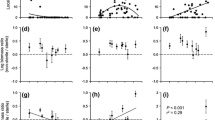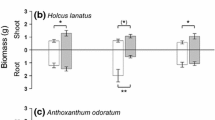Abstract
Interactions between plants and soil microorganisms influence individual plant performance and thus plant-community composition. Most studies on such plant-soil feedbacks (PSFs) have been performed under controlled greenhouse conditions, whereas no study has directly compared PSFs under greenhouse and natural field conditions. We grew three grass species that differ in local abundance in grassland communities simultaneously in the greenhouse and field on field-collected soils either previously conditioned by these species or by the general grassland community. As soils in grasslands are typically conditioned by mixes of species through the patchy and heterogeneous plant species’ distributions, we additionally compared the effects of species-specific versus non-specific species conditioning on PSFs in natural and greenhouse conditions. In almost all comparisons PSFs differed between the greenhouse and field. In the greenhouse, plant growth in species-specific and non-specific soils resulted in similar effects with neutral PSFs for the most abundant species and positive PSFs for the less abundant species. In contrast, in the field all grass species tested performed best in non-specific plots, whereas species-specific PSFs were neutral for the most abundant and varied for the less abundant species. This indicates a general beneficial effect of plant diversity on PSFs in the field. Controlled greenhouse conditions might provide valuable insights on the nominal effects of soils on plants. However, the PSFs observed in greenhouse conditions may not be the determining drivers in natural plant communities where their effects may be overwhelmed by the diversity of abiotic and biotic above- and belowground interactions in the field.




Similar content being viewed by others
References
Bartelt-Ryser J, Joshi J, Schmid B, Brandl H, Balser T (2005) Soil feedbacks of plant diversity on soil microbial communities and subsequent plant growth. Perspect Plant Ecol Evol Syst 7:27–49. doi:10.1016/j.ppees.2004.11.002
Bauer JT, Mack KML, Bever JD (2015) Plant-soil feedbacks as drivers of succession: evidence from remnant and restored tallgrass prairies. Ecosphere 6:1–12. doi:10.1890/ES14-00480.1
Bever JD (1994) Feedback between plants and their soil communities in an old field community. Ecology 75:1965–1977. doi:10.1111/j.1365-2745.2006.01104.x
Bever JD (2003) Soil community feedback and the coexistence of competitors: conceptual frameworks and empirical tests. New Phytol 157:465–473. doi:10.1046/j.1469-8137.2003.00714.x
Bever JD, Westover KM, Antonovics J (1997) Incorporating the soil community into plant population dynamics: the utility of the feedback approach. J Ecol 85:561–573. doi:10.2307/2960528
Bever JD, Dickie IA, Facelli E, Facelli JM, Klironomos JN, Moora M, Rillig MC, Stock WD, Tibbett M, Zobel M (2010) Rooting theories of plant community ecology in microbial interactions. Trends Ecol Evol 25:468–478. doi:10.1016/j.tree.2010.05.004
Bever JD, Mangan SA, Alexander HM (2015) Maintenance of plant species diversity by pathogens. Annu Rev Ecol Evol Syst 46:305–325. doi:10.1146/annurev-ecolsys-112414-054306
Bezemer TM, Lawson CS, Hedlund K, Edwards AR, Brook AJ, Igual JM, Mortimer SR, van der Putten WH (2006) Plant species and functional group effects on abiotic and microbial soil properties and plant-soil feedback responses in two grasslands. J Ecol 94:893–904. doi:10.1111/j.1365-2745.2006.01158.x
Bonanomi G, Giannino F, Mazzoleni S (2005) Negative plant-soil feedback and species coexistence. Oikos 111:311–321. doi:10.1111/j.0030-1299.2005.13975.x
Brinkman EP, van der Putten WH, Bakker E-J, Verhoeven KJF (2010) Plant-soil feedback: experimental approaches, statistical analyses and ecological interpretations. J Ecol 98:1063–1073. doi:10.1111/j.1365-2745.2010.01695.x
Casper BB, Castelli JP (2007) Evaluating plant-soil feedbacks together with competition in a serpentine grassland. Ecol Lett 10:394–400. doi:10.1111/j.1461-0248.2007.01030.x
Casper BB, Bentivenga SP, Ji B, Doherty JH, Edenbern HM, Gustafson DJ (2008) Plant-soil feedback: testing the generality with the same grasses in serpentine and prairie soils. Ecology 89:2154–2164. doi:10.1890/07-1277.1
Chiuffo MC, MacDougall AS, Hierro JL (2015) Native and non-native ruderals experience similar plant-soil feedbacks and neighbor effects in a system where they coexist. Oecologia 179:843–852. doi:10.1007/s00442-015-3399-y
Ehrenfeld JG, Ravit B, Elgersma K (2005) Feedback in the plant-soil system. Annu Rev Environ Resour 30:75–115. doi:10.1146/annurev.energy.30.050504.144212
Fraser LH, Grime JP (1998) Top-down control and its effect on the biomass and composition of three grasses at high and low soil fertility in outdoor microcosms. Oecologia 113:239–246. doi:10.1007/s004420050374
Fricke EC, Tewksbury JJ, Rogers HS (2014) Multiple natural enemies cause distance-dependent mortality at the seed-to-seedling transition. Ecol Lett 17:593–598. doi:10.1111/ele.12261
Grime JP (1977) Evidence for the existence of three primary strategies in plants and its relevance to ecological and evolutionary theory. Am Nat 111:1169–1194
Gustafson DJ, Casper BB (2004) Nutrient addition affects AM fungal performance and expression of plant/fungal feedback in three serpentine grasses. Plant Soil 259:9–17. doi:10.1023/B:PLSO.0000020936.56786.a4
Heinze J, Bergmann J, Rillig MC, Joshi J (2015a) Negative biotic soil-effects enhance biodiversity by restricting potentially dominant plant species in grasslands. Perspect Plant Ecol Evol Syst 17:227–235. doi:10.1016/j.ppees.2015.03.002
Heinze J, Werner T, Weber E, Rillig MC, Joshi J (2015b) Soil biota effects on local abundances of three grass species along a land-use gradient. Oecologia. doi:10.1007/s00442-015-3336-0
Hurlbert SH (1984) Pseudoreplication and the design of ecological field experiments. Ecol Monogr 54:187–211. doi:10.2307/1942661
Jackson RB, Canadell J, Ehleringer JR, Mooney HA, Sala OE, Schulze ED (1996) A global analysis of root distributions for terrestrial biomes. Oecologia 108:389–411. doi:10.1007/BF00333714
Johnson NC, Wilson GWT, Bowker MA, Wilson JA, Miller RM (2010) Resource limitation is a driver of local adaptation in mycorrhizal symbioses. PNAS 107:2093–2098. doi:10.1073/pnas.0906710107
Kardol P, Cornips NJ, van Kempen MML, Bakx-Schotman JMT, van der Putten WH (2007) Microbe-mediated plant-soil feedback causes historical contingency effects in plant community assembly. Eco Monogr 77:147–162. doi:10.1890/06-0502
Klironomos JN (2002) Feedback with soil biota contributes to plant rarity and invasiveness incommunities. Nature 417:67–70. doi:10.1038/417067a
Klotz S, Kühn I, Durka W (2002) BIOLFLOR–eine Datenbank zu biologisch-ökologischen Merkmalen der Gefäßpflanzen in Deutschland. Bundesamt für Naturschutz, Bonn. Schriftenreihe für Vegetationskunde 38
Kneis D, Knoesche R, Bronstert A (2006) Analysis and simulation of nutrient retention and management for a lowland river-lake system. Hydrol Earth Syst Sci 10:575–588
Kulmatiski A, Kardol P (2008) Getting plant-soil feedbacks out of the greenhouse: experimental and conceptual approaches. In: Lüttge U, Beyschlag W, Murata J (eds) Progress in botany 69. Springer, Heidelberg, pp 449–472. doi:10.1007/978-3-540-72954-9_18
Kulmatiski A, Beard KH, Stevens JR, Cobbold SM (2008) Plant-soil feedbacks: a meta-analytic review. Ecol Lett 11:980–992. doi:10.1111/j.1461-0248.2008.01209.x
Kulmatiski A, Heavilin J, Beard KH (2011) Testing predictions of a three-species plant-soil feedback model. J Ecol 99:542–550. doi:10.1111/j.1365-2745.2010.01784.x
Mangan SA, Schnitzer SA, Herre EA, Mack KML, Valencia MC, Sanchez EI, Bever JD (2010) Negative plant-soil feedback predicts tree-species relative abundance in a tropical forest. Nature 466:752–755. doi:10.1038/nature09273
McConnaughay KDM, Berntson GM, Bazzaz FA (1993) Limitations to CO2-induced growth enhancement in pot studies. Oecologia 94:550–557. doi:10.1007/BF00566971
Mokany K, Raison RJ, Prokushkin AS (2006) Critical analysis of root:shoot ratios in terrestrial biomes. Glob Change Biol 12:84–96. doi:10.1111/j.1365-2486.2005.001043.x
Morris WF, Hufbauer RA, Agrawal AA, Bever JD, Borowitz VA, Gilbert GS, Maron JL, Mitchell CE, Parker IM, Power AG, Torchin ME, Vàzquez DP (2007) Direct and interactive effects of enemies and mutualists on plant performance: a meta-analysis. Ecology 88:1021–1029. doi:10.1890/06-0442
Müller KE, Tilman D, Fornara DA, Hobbie SE (2013) Root depth distribution and the diversity–productivity relationship in a long-term grassland experiment. Ecology 94:787–793. doi:10.1890/12-1399.1
Mwangi PN, Schmitz M, Scherber C, Roscher C, Schumacher J, Scherer-Lorenzen M, Weisser WW, Schmid B (2007) Niche pre-emption increases with species richness in experimental plant communities. J Ecol 95:65–78. doi:10.1111/j.1365-2745.2006.01189.x
Olsen SR, Cole CV, Watanabe FS, Dean LA (1954) Estimation of available phosphorus in soils by extraction with sodium bicarbonate. USDA Circular 939:1–19. Government Printing Office, Washington, DC
Peltzer DA (2001) Plant responses to competition and soil origin across a prairie–forest boundary. J Ecol 89:176–185. doi:10.1046/j.1365-2745.2001.00544.x
Petermann JS, Fergus AJF, Turnbull LA, Schmid B (2008) Janzen–Connell effects are widespread and strong enough to maintain diversity in grasslands. Ecology 89:2399–2406. doi:10.1890/07-2056.1
Pizano C, Mangan SC, Graham JH, Kitajima K (2014) Habitat-specific positive and negative effects of soil biota on seedling growth in a fragmented tropical montane landscape. Oikos 123:846–856. doi:10.1111/oik.01032
Poorter H, Niklas KJ, Reich PB, Oleksyn J, Poot P, Mommer L (2012) Biomass allocation to leaves, stems and roots: meta-analyses of interspecific variation and environmental control. New Phytol 193:30–50. doi:10.1111/j.1469-8137.2011.03952.x
R Development Core Team (2014) R: a language and environment for statistical computing. R Foundation for Statistical Computing, Vienna
Reinhart KO (2012) The organization of plant communities: negative plant-soil feedbacks and semiarid grasslands. Ecology 93:2377–2385. doi:10.1890/12-0486.1
Rottstock T, Joshi J, Kummer V, Fischer M (2014) Higher plant diversity promotes higher diversity of fungal pathogens, while it decreases pathogen infection per plant. Ecology 95:1907–1917. doi:10.1890/13-2317.1
Solaiman MZ, Hirata H (1997) Effect of arbuscular mycorrhizal fungi inoculation of rice seedlings at the nursery stage upon performance in the paddy field and greenhouse. Plant Soil 191:1–12. doi:10.1023/A:1004238028617
Soliveres S, Maestre FT, Ulbrich W, Manning P, Boch S, Bowker MA, Prati D, Delgado-Baquerizo M, Quero JL, Schöning I, Gallardo A, Weisser W, Müller J, Socher SA, García-Gómez M, Ochoa V, Schulze ED, Fischer M, Allen E (2015) Intransitive competition is widespread in plant communities and maintains their species richness. Ecol Lett 18:790–798. doi:10.1111/ele.12456
Van de Voorde TFJ, van der Putten WH, Bezemer TM (2011) Intra- and interspecific plant-soil interactions, soil legacies and priority effects during old-field succession. J Ecol 99:945–953. doi:10.1111/j.1365-2745.2011.01815
van der Putten WH, Kowalchuk GA, Brinkman EP, Doodeman GTA, van der Kaaij RM, Kamp AFD, Menting FBJ, Veenendaal EM (2007) Soil feedback of exotic savanna grass relates to pathogen absence and mycorrhizal selectivity. Ecology 88:978–988. doi:10.1890/06-1051
van der Putten WH, Bardgett RD, Bever JD, Bezemer TM, Casper BB, Fukami T, Kardol P, Klironomos JN, Kulmatiski A, Schweitzer JA, Suding KN, van de Voorde TFJ, Wardle DA (2013) Plant-soil feedbacks: the past, the present and future challenges. J Ecol 101:265–276. doi:10.1111/1365-2745.12054
Wardle DA, Bardgett RD, Klironomos JN, Setälä H, van der Putten WH, Wall DH (2004) Ecological linkages between aboveground and belowground biota. Science 304:1629–1633. doi:10.1126/science.1094875
Acknowledgments
We thank Ewald Weber for helpful comments on the manuscript, Frank Warschau for help in the field, Gabriele Gehrmann for help with the soil analyses and the Botanical Garden Potsdam for their cooperation.
Author information
Authors and Affiliations
Corresponding author
Ethics declarations
Author contribution statement
J. H. designed the study. J. H., M. S. and A. S. performed the experiments. J. H., J. W., and J. J. analyzed the data. J. H., J. W. and J. J. wrote the first draft of the manuscript; all authors contributed substantially to the revisions.
Additional information
Communicated by Edith B. Allen.
Electronic supplementary material
Below is the link to the electronic supplementary material.
Rights and permissions
About this article
Cite this article
Heinze, J., Sitte, M., Schindhelm, A. et al. Plant-soil feedbacks: a comparative study on the relative importance of soil feedbacks in the greenhouse versus the field. Oecologia 181, 559–569 (2016). https://doi.org/10.1007/s00442-016-3591-8
Received:
Accepted:
Published:
Issue Date:
DOI: https://doi.org/10.1007/s00442-016-3591-8




